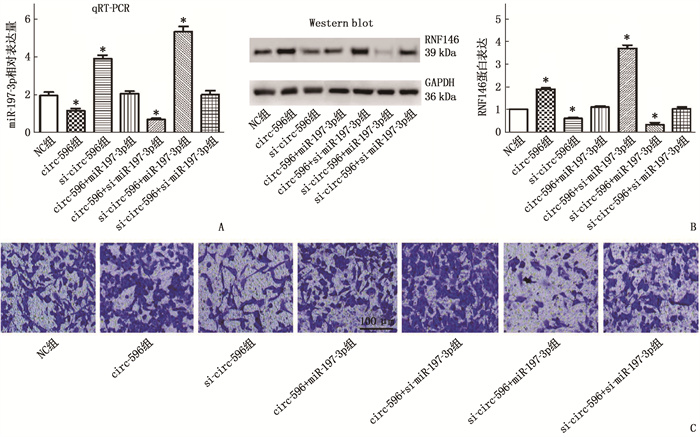Mechanism of hsa_circRNA_0000596 in promoting invasion and metastasis of cervical cancer cells
-
摘要:目的
探讨hsa_circRNA_000596(circ-596)促进宫颈癌细胞侵袭和转移的作用机制。
方法收集69例宫颈鳞状细胞癌(CSCC)手术患者的CSCC组织、癌旁正常宫颈组织及临床资料。采用RNA原位杂交(RISH)技术检测circ-596阳性表达情况, 并分析其与CSCC患者临床特征的关系。采用Transwell实验检测宫颈癌细胞的侵袭能力; 采用实时荧光定量聚合酶链反应(qRT-PCR)实验检测circ-596对下游靶基因的影响; 采用双荧光素酶报告基因实验验证miR-197-3p对下游靶基因RNF146的调控作用; 采用Rescue实验分析circ-596对miR-197-3p/RNF146信号通路及细胞侵袭能力的影响。
结果circ-596在CSCC组织中主要呈阳性表达,阳性表达率为63.77%(44/69), 高于癌旁正常组织的17.39%(12/69), 差异有统计学意义(χ2=8.254, P=0.004)。circ-596阳性表达与肿瘤分化程度、淋巴结转移均密切相关(P < 0.05)。Transwell实验结果显示,与对照细胞相比,过表达circ-596的宫颈癌细胞侵袭数目增加,敲低circ-596表达的细胞侵袭数目减少,差异均有统计学意义(P < 0.05)。生物信息学预测结果显示, miR-197-3p是circ-596的下游靶基因, RNF146是miR-197-3p的下游靶基因。qRT-PCR实验结果显示,过表达circ-596能下调miR-197-3p的表达,降低circ-596表达能上调miR-197-3p的表达,差异有统计学意义(P < 0.05)。双荧光素酶报告基因实验结果显示, miR-197-3p与RNF146基因的3'UTR结合,从而抑制荧光素酶相对活性。Rescue实验结果显示, circ-596能够抑制miR-197-3p的表达,进而促进RNF146的表达,提升宫颈癌细胞的侵袭能力。
结论CSCC组织中circ-596主要呈阳性表达,且其阳性表达情况与肿瘤分化程度和淋巴结转移密切相关。circ-596通过结合miR-197-3p, 促进RNF146的表达,进而促进宫颈癌细胞的侵袭和转移。
-
关键词:
- 宫颈鳞状细胞癌 /
- hsa_circRNA_0000596 /
- 微小RNA-197-3p /
- RNF146基因 /
- 侵袭 /
- 转移
Abstract:ObjectiveTo investigate the mechanism of hsa_circRNA_000596 (circ-596) in promoting invasion and metastasis of cervical cancer cells.
MethodsThe cervical squamous cell carcinoma (CSCC) tissue, normal cervical tissue adjacent to cancer and clinical data of 69 cases with CSCC were collected. RNA in situ hybridization (RISH) was used to detect the expression of circ-596 and analyze its association with clinical data of CSCC. The invasive ability of cervical cancer cells was detected by Transwell assay; the regulation of downstream target gene by circ-596 was detected by quantitative reverse transcriptase PCR (qRT-PCR). Dual luciferase reporting experiment was used to verify the regulation of miR-197-3p on the downstream target gene RNF146; the regulation of miR-197-3p/RNF146 by circ-596 and its effect on invasion ability were analyzed in rescue experiment.
ResultsCirc-596 was mainly positively expressed in CSCC tissues, and the positive expression rate was 63.77%(44/69), which was higher than 17.39% (12/69) in adjacent normal tissues (χ2=8.254, P=0.004). Circ-596 positive expression was closely correlated with tumor differentiation and lymph node metastasis (P < 0.05). The results of Transwell experiment showed that compared with the control cells, the number of cervical cancer cells with overexpression of circ-596 increased, and the number of cells with knockdown expression of circ-596 decreased (P < 0.05). Bioinformatics prediction results showed that miR-197-3p was the downstream target gene of circ-596, and RNF146 was the downstream target gene of miR-197-3p. The results of qRT-PCR showed that overexpression of circ-596 could down-regulate the expression of miR-197-3p, and down-expression of circ-596 could up-regulate the expression of miR-197-3p (P < 0.05). The results of dual luciferase reporter gene experiments showed that miR-197-3p bound to the 3'UTR of RNF146 gene, thereby inhibiting the relative activity of luciferase. Rescue experiment results showed that circ-596 could inhibit the expression of miR-197-3p, and thereby promoting the expression of RNF146, and enhancing the invasion ability of cervical cancer cells.
ConclusionCirc-596 is mainly positively expressed in CSCC tissues, and its positive expression is closely related to the degree of tumor differentiation and lymph node metastasis. Circ-596 promotes the expression of RNF146 by binding to miR-197-3p, thereby promoting the invasion and metastasis of cervical cancer cells.
-
Keywords:
- cervical squamous cell carcinoma /
- hsa_circRNA_0000596 /
- microRNA 197-3p /
- RNF146 gene /
- invasion /
- metastasis
-
-
表 1 CSCC组织中circ-596表达情况与患者临床特征的关系[n(%)]
特征 分类 阳性表达组(n=44) 正常或阴性表达组(n=25) χ2 P 年龄 <50岁 25(56.82) 14(56.00) 0.004 0.947 ≥50岁 19(43.18) 11(44.00) 人乳头瘤病毒感染 有 24(54.55) 13(52.00) 0.042 0.839 无 20(45.45) 12(48.00) 肿瘤直径 ≤4 cm 30(68.18) 16(64.00) 0.125 0.723 >4 cm 14(31.82) 9(36.00) 肿瘤分化程度 高分化 14(31.82) 16(64.00) 6.719 0.010 中-低分化 30(68.18) 9(36.00) 淋巴结转移 有 22(50.00) 5(20.00) 6.024 0.014 无 22(50.00) 20(80.00) TNM分期 Ⅰ~Ⅱ期 22(50.00) 14(56.00) 0.641 0.423 Ⅲ期 22(50.00) 11(44.00) 表 2 宫颈癌细胞侵袭数目、miR-197-3p RNA表达量、RNF146蛋白水平(n=3)
组别 miR-197-3p相对表达量 侵袭细胞数目/(个/视野) RNF146蛋白表达量 NC组 1.963±0.177 65.6±6.4 1.000±0 circ-596组 1.167±0.121* 97.2±7.6* 1.901±0.059* anti-circ-596组 3.900±0.173* 44.1±3.1* 0.602±0.058* circ-596+miR-197-3p组 2.067±0.120 67.8±5.8 1.102±0.057 circ-596+anti-miR-197-3p组 0.700±0.058* 127.9±6.7* 3.701±0.153* anti-circ-596+miR-197-3p组 5.300±0.289* 26.5±2.2* 0.334±0.086* anti-circ-596 +anti-miR-197-3p组 2.000±0.208 68.3±3.1 1.033±0.088 与NC组比较, *P < 0.05。 -
[1] 殷华芳, 沙莎, 蔡依玲, 等. 宫颈癌放射治疗相关卵巢损伤的分子机制及防治策略研究进展[J]. 实用临床医药杂志, 2024, 28(10): 141-144. doi: 10.7619/jcmp.20240044 [2] WANG W, LUO H X, CHANG J J, et al. Circular RNA circ0001955 promotes cervical cancer tumorigenesis and metastasis via the miR-188-3p/NCAPG2 axis[J]. J Transl Med, 2023, 21(1): 356. doi: 10.1186/s12967-023-04194-4
[3] LUO H X, LI Y X, ZHAO Y Y, et al. Comprehensive analysis of circRNA expression profiles during cervical carcinogenesis[J]. Front Oncol, 2021, 11: 676609. doi: 10.3389/fonc.2021.676609
[4] ABU-RUSTUM N R, YASHAR C M, BEAN S, et al. NCCN guidelines insights: cervical cancer, version 1. 2020[J]. J Natl Compr Canc Netw, 2020, 18(6): 660-666. doi: 10.6004/jnccn.2020.0027
[5] YU H, LIU P L, CHEN T L. CircIFFO1 suppresses tumor growth and metastasis of cutaneous squamous cell carcinoma by targeting the miR-424-5p/NFIB axis[J]. Arch Dermatol Res, 2023, 315(9): 2585-2596. doi: 10.1007/s00403-023-02659-6
[6] TANG Q, HANN S S. Biological roles and mechanisms of circular RNA in human cancers[J]. Onco Targets Ther, 2020, 13: 2067-2092. doi: 10.2147/OTT.S233672
[7] ZHU G M, CHANG X Y, KANG Y C, et al. CircRNA: a novel potential strategy to treat thyroid cancer (Review)[J]. Int J Mol Med, 2021, 48(5): 201. doi: 10.3892/ijmm.2021.5034
[8] 蔡祎品, 黄海伟, 刘晓丽, 等. 术前控制营养状态评分与宫颈癌患者术后复发、转移的关系[J]. 实用临床医药杂志, 2023, 27(11): 17-22, 31. doi: 10.7619/jcmp.20223350 [9] SHARMA S, DEEP A, SHARMA A K. Current treatment for cervical cancer: an update[J]. Anticancer Agents Med Chem, 2020, 20(15): 1768-1779. doi: 10.2174/1871520620666200224093301
[10] CHENG J H, LI G Y, WANG W M, et al. Circular RNAs with protein-coding ability in oncogenesis[J]. Biochim Biophys Acta Rev Cancer, 2023, 1878(4): 188909. doi: 10.1016/j.bbcan.2023.188909
[11] GUZ M, JELENIEWICZ W, CYBULSKI M. Interactions between circRNAs and miR-141 in cancer: from pathogenesis to diagnosis and therapy[J]. Int J Mol Sci, 2023, 24(14): 11861. doi: 10.3390/ijms241411861
[12] ZHANG C Y, JIANG H Y, YUAN L, et al. CircVPRBP inhibits nodal metastasis of cervical cancer by impeding RACK1 O-GlcNAcylation and stability[J]. Oncogene, 2023, 42(11): 793-807. doi: 10.1038/s41388-023-02595-9
[13] TIAN R, LI H X, REN S J, et al. circRNA THBS1 silencing inhibits the malignant biological behavior of cervical cancer cells via the regulation of miR-543/HMGB2 axis[J]. Open Med, 2023, 18(1): 20230709. doi: 10.1515/med-2023-0709
[14] LI H, ZHENG S L, WAN T, et al. Circular RNA circ_0000212 accelerates cervical cancer progression by acting as a miR-625-5p sponge to upregulate PTP4A1[J]. Anticancer Drugs, 2023, 34(5): 659-668. doi: 10.1097/CAD.0000000000001435
[15] LI Y, MENG F D, SUI C G, et al. CircRNA hsa_circ_0001627 aggravates cervical cancer progression through upregulation of FNDC3B and activating PI3K/mTOR signaling pathway[J]. J Cell Commun Signal, 2023, 17(3): 627-638. doi: 10.1007/s12079-022-00696-w
-
期刊类型引用(2)
1. 何君梅,李思宇,唐志红. 创伤性颅脑损伤的临床治疗进展. 中国临床医生杂志. 2025(01): 19-23 .  百度学术
百度学术
2. 吴碧珠. 集束化护理干预对外伤性颅脑损伤患者负性情绪、生命质量及睡眠质量的影响. 世界睡眠医学杂志. 2023(08): 1896-1899 .  百度学术
百度学术
其他类型引用(0)





 下载:
下载:




 苏公网安备 32100302010246号
苏公网安备 32100302010246号

